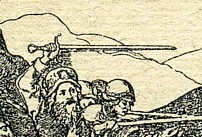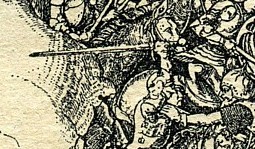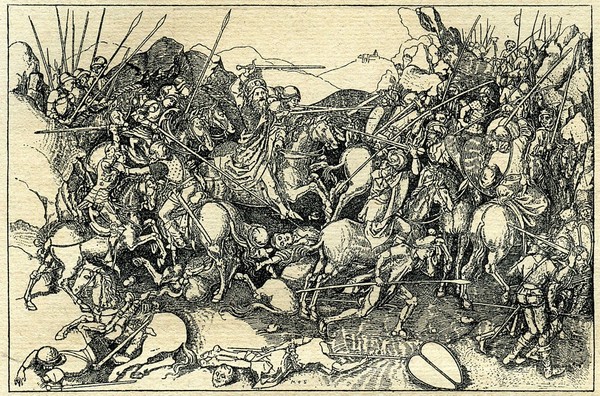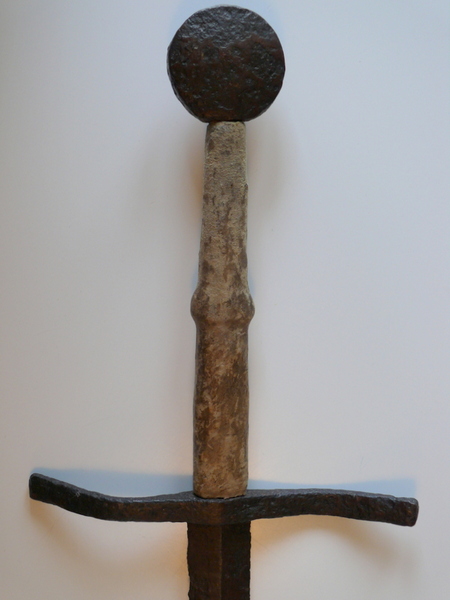| Author |
Message |
Matt Easton

Location: Surrey, UK. Joined: 30 Jun 2004
Posts: 241
|
 Posted: Wed 13 Jun, 2012 8:31 am Post subject: Posted: Wed 13 Jun, 2012 8:31 am Post subject: |
 |
|
It's not as simple as that.
'Civilians' (which could of course be soldiers not on service), carried swords at various times since swords were invented. They didn't magically start carry swords at a certain date. Ironically, given the above post, it was illegal for civilians in English cities to carry swords or bucklers from the 13th century onwards. They could carry swords when outside cities or when entering or leaving, but they could not carry them within English cities unless they were knighted or one of the Mayor's aldermen (the equivalent of the police). This law was repeatedly issued through the 13th and 14th centuries and the last record I have of it being issued is in the first half of the 15th century. Probably partly due to the Wars of the Roses this law seems to have been slowly abandoned in the 15th century in England and by the 16th century it seems that sword-wearing was tolerated in English cities. However, note that fencing and wrestling contests continued to be held *outside* the city walls, even in the later 16th century.
England though is just one example. The laws in every country varied - France had similar laws to England, but in German and Italy it seems that weapon-carrying in cities was more tolerated in the 13th-15th century than it was in England or France.
In other words, there is no simple answer. Europe was just as diverse and with just as varying laws as it is now.
Schola Gladiatoria - www.swordfightinglondon.com
YouTube: www.youtube.com/user/scholagladiatoria
Antique Swords: www.antique-swords.co.uk/
|
|
    |
 |
Luka Borscak

|
 Posted: Wed 13 Jun, 2012 3:04 pm Post subject: Posted: Wed 13 Jun, 2012 3:04 pm Post subject: |
 |
|
|
I edited my post so that I don't mislead people with false info...
|
|
  |
 |
|
Ryan S.
|
 Posted: Thu 14 Jun, 2012 9:12 am Post subject: Posted: Thu 14 Jun, 2012 9:12 am Post subject: |
 |
|
|
would you say then that most of the people carrying swords would either be soldiers off to war, or paramilitary police or body guards and therefore carrying them professionally, not for fashion?
|
|
  |
 |
|
Neil Melville
|
 Posted: Sat 07 Jul, 2012 10:39 am Post subject: Posted: Sat 07 Jul, 2012 10:39 am Post subject: |
 |
|
Hello Levente,
I am particularly interested in the two-handed swords from the Castillon hoard, and in fact have a replica of the one now in the Royal Armouries, Leeds. I know of the one in your photo at the beginning of this post, sold at Hermann Historica's auction in April 2006, but I did not know where it had gone. Your photo implies that it has been loaned to a museum by its new owners - could you tell me (and everyone else) what museum has it on display. Many thanks.
Neil
N Melville
|
|
  |
 |
|
Cornelis Tromp
Location: Holland Joined: 03 Jan 2010
Posts: 87
|
 Posted: Mon 09 Jul, 2012 11:46 pm Post subject: Posted: Mon 09 Jul, 2012 11:46 pm Post subject: |
 |
|
late 15thC 2-hand swords with recurved guards, Oakeshott type XVIIIb.
These swords were found in the literature and drawings from 1425 to about 1520, for example drawn by Albrecht Dürer and Martin Schoengrauer, see drawing Schoengrauer from 1475.
Historical examples of this type of sword are Wallace A467, nr 11829 Cluny, and the famous sword from the Bavarian National Museum, Munich (XVIIIa.5 ROMs).
Also some pictures from a true fighting sword , ex Gottlob Herbert Bidermann collection.
to high probability a water discovery with the original handle intact.
The sword length is 124cm, blade 97.5cm/3.5cm/1cm.,pommel 5.9cm, grip-l 19cm, cross-w 21.5cm, weight 1392gr.
best,
 Attachment: 17.93 KB Attachment: 17.93 KB

 Attachment: 27.52 KB Attachment: 27.52 KB

 Attachment: 152.36 KB Attachment: 152.36 KB

 Attachment: 35.47 KB Attachment: 35.47 KB

 Attachment: 96.78 KB Attachment: 96.78 KB

|
|
  |
 |
Konstantin Tsvetkov

|
 Posted: Tue 10 Jul, 2012 2:23 am Post subject: Re: 15th century "two-handed swords" Posted: Tue 10 Jul, 2012 2:23 am Post subject: Re: 15th century "two-handed swords" |
 |
|
| Levente M. wrote: | Hello!
So basically my question is, what was the function of these swords? What are they?
Now I have two theories, but i'm quite new to the world of swords so I could be very wrong.
1. They were longswords used by large men. For example, I'm quite tall, 195 cm and have big hands. Albion's Talhoffer feels small to me, there's almost no space between my hands when I hold the grip. I also feel i could handle more weight and I'd be more effective with a longer blade.
2. It was used similarly to a zweihander, pollaxe or halberd, and a secondary, smaller sword was carried on the belt.
So can someone clear up my confusion please? 
Thanks! |
Dear Levente,
Thank you very much for starting this thread. I was speculating about this matter for quite long and your questions encouraged me to make some researches. In the beginning of this month arrived my Albion Maximilian sword. It is 140 cm long, blade length is 104 cm, weight 2.3 kilos, so this weapon fits well the category you speak about.
1. I am 188 cm tall and consider myself strong enough. I have been practicing long sword (Fiore system) for several years. My 18-year old son is 195 cm tall, he has been practicing martial arts since the age of 10, Fiore system for more than 3 years. He is very athletic. We tried some solo drills from Fiore using Albion Maximilian and our experience is that it does not work properly even for a big and strong person. An opponent armed with a lighter weapon would have advantage in speed and agility. I heard the story, that Russian cavalry officers fighting in Caucasus in XIX century, very quickly abandoned regulation swords in favor of captured or privately purchased, lighter and thinner eastern blades, used by their opponents. The reason was that a Russian trooper using a regulation sword often received one or two cuts from his opponent before he even managed to parry.
There was a time when I intentionally used heavy swords for training, but the heaviest weighted about 1.8 kilos. One kilogram of extra weight, as in case of two-handed sword, is too much for effective application of hand and a half sword technics even for a big person. By the way, Albion Talhoffer is not the largest sword in the line and it has a relatively small grip, probably The Munich or The Regent would work better for you.
2. Your second question.
John Clements in his works “Medieval Swordsmanship” on pages 39-42 and “Renaissance Swordsmanship” on pages 115-116 describes evolution and use of swords in questions and I, personally, share his point of view. I don’t have a copy of Marozzo manuscript, but Sir Alfred Hutton in his “Old Sword Play” comments the Marozzo two-hand sword system, plates included in the book. Interesting is, that Sir Alfred Hutton did not mentioned long sword at all in his book.
My son George once attended a Renaissance two-hand sword and pole weapons seminar given by Mr.Tom Leoni in Helsinki. Primer use of two-handed sword against pole weapons was the idea there.
If some of you knows other sources for two-handed sword technics, please share them with us.
|
|
  |
 |
Mark T

|
 Posted: Tue 10 Jul, 2012 3:15 am Post subject: Posted: Tue 10 Jul, 2012 3:15 am Post subject: |
 |
|
| Scott Woodruff wrote: | | I recently read an article whose author offered the opinion that WMA practitioners should use longer longswords because that makes the techniques "clearer". With the smaller swords (90cm blade) larger people can more easily disengage from the bind and are less likely to work from the bind as the manuscripts show. He offered a lot of evidence from period longsword manuscripts that longswords would be quite large in proportion to their users. I will try to remember where I saw that article and post a link if I find it. |
Scott, did you mean 'How long should a longsword be?' by Roger Norling?
It's also worth checking out Tilman Wanke's 'Anderhalbhänder - Zweihänder - Langes Schwert: zu Klassifkation, Nutzung und Bezeichung der großen Schwerter des Spätmittelalters und der frühen Neuzet': http://www.schwertkampf-ochs.de/Essays/aufsat...ert_v1.pdf
Cheers,
Mark T
Chief Librarian/Curator, Isaac Leibowitz Librarmoury
Schallern sind sehr sexy!
|
|
  |
 |
Matt Easton

Location: Surrey, UK. Joined: 30 Jun 2004
Posts: 241
|
 Posted: Thu 12 Jul, 2012 7:48 am Post subject: Posted: Thu 12 Jul, 2012 7:48 am Post subject: |
 |
|
| Ryan S. wrote: | | would you say then that most of the people carrying swords would either be soldiers off to war, or paramilitary police or body guards and therefore carrying them professionally, not for fashion? |
According to the sources available to me, it seems that in the 14th-15thC in England and France there were essentially 4 groups of people who would commonly carry swords:
1) Nobles who had been knighted, or higher rank, carrying a sword for status
2) Soldiers on campaign
3) Civilians who were travelling between cities/towns (eg. Chaucer)
4) Criminals who were doing naughty things
This 4th group are actually amongst the best documented, because the sources are full of examples of men being arrested for walking about after curfew armed or getting into fights (this shows that people did carry swords against the law, but it also shows that they were punished for it and it was therefore probably not that common).
Wounding and killing was heavily punished under Anglo-French medieval law, unless it was categorically proven to be self-defence. Carrying a sword was regarded as 'looking for trouble', unless you had a specific lawful reason to be doing so. Even most knights and higher nobles do not seem to have carried swords very often. Remember though that almost everyone had a knife or dagger.
Casual sword-wearing does not seem to have spread in most of Europe until the end of the 15thC and beginning of the 16thC.
Regarding the sources for the use of big two-handed swords, there are a number of them. Examples include Marozzo, Alfieri and 'Goliath'.
Matt
Schola Gladiatoria - www.swordfightinglondon.com
YouTube: www.youtube.com/user/scholagladiatoria
Antique Swords: www.antique-swords.co.uk/
|
|
    |
 |
|
|
You cannot post new topics in this forum
You cannot reply to topics in this forum
You cannot edit your posts in this forum
You cannot delete your posts in this forum
You cannot vote in polls in this forum
You cannot attach files in this forum
You can download files in this forum
|
All contents © Copyright 2003-2024 myArmoury.com — All rights reserved
Discussion forums powered by phpBB © The phpBB Group
Switch to the Basic Low-bandwidth Version of the forum
|

